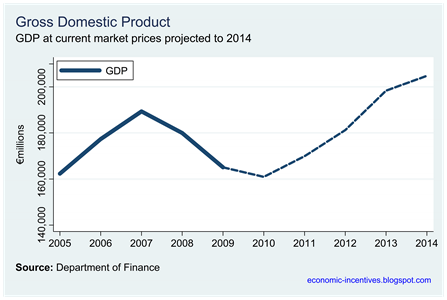This €7.5 billion adjustment over the period 2011-2014 was a figure that surprised me. I thought it was more. Karl Whelan provides the answer.
The analysis of the economy and how we were due to reach the 3% deficit target by 2014 was provided in the December 2009 Stability Programme Update produced with the Budget. Here are the General Government Deficit Projections from that document (Table 1, page 6).
| Year | 2009 | 2010 | 2011 | 2012 | 2013 | 2014 |
| GGD (%GDP) | -11.7% | -11.6% | -10.0% | -7.2% | -4.9% | -2.9% |
As if by magic, the numbers produced in the Update lead us to a General Government Balance of –2.9% of GDP in 2014 – just where we want to be. Getting below the key 3% level is based on two elements:
- Projected GDP growth in the economy
- Cumulative fiscal adjustments in the government accounts.
We already know that the above deficit figures for 2009 and 2010 are misleading as they exclude the costs of the banking bailout. The 2009 deficit was 14.3% of GDP and the projected deficit for 2010 is over 32% of GDP! The hope is that the costs of the banking bailout will be once-off (though they will leave a debt interest legacy) and that over the next four years we can turn to dealing with the structural deficit.
Here was how we planned to narrow the gap.

The actual projected amounts (in €millions) are shown below.

It is clear that the ‘strategy’ was two-fold
- Try to taper the nominal increases in expenditure, while using cuts to bring expenditure as a percentage of GDP down from nearly 47% to 40%,
- Hope for substantial buoyancy in revenues of existing taxes with government revenue as a percentage of GDP increasing by only two percentage points from 35% to 37%.
| Year | 2009 | 2010 | 2011 | 2012 | 2013 | 2014 |
| GDP (current prices) | 164,600 | 160,925 | 169,900 | 181,250 | 192,975 | 204,800 |
| Growth (constant prices) | -7.5% | -1.3% | +3.3% | +4.5% | +4.3% | +4.0% |
Graphing these numbers shows just how much of a dramatic turnaround the Department was hoping for.

This isn’t an economy “turning the corner”, it’s more akin to “reaching lift-off”! These growth projections are wildly optimistic and we didn’t need clandestine briefings in the Department of Finance to tell us that.
The EU Commission pointed this out back in March (report here). As we noted at the time the Commission concluded:
The budgetary outcomes could be worse than targeted throughout the programme period, mainly due toSo back in March, the EU Commission clearly believed that the outcomes could be worse than the projections and in point 2 clearly point to the “favourable macroeconomic outlook” in the programme. Yet, this seemed to come as a surprise to everyone this week.
- The fact that the consolidation efforts planned after 2010 are not underpinned by broad measures and are of an indicative nature only;
- The programme's favourable macroeconomic outlook after 2010; and
- The risk of expenditure overruns in 2010 and also beyond, to the extent that the still to be spelled out strategy should rely on expenditure restraint.
In fact, we didn’t need the EU to tell us that these projections were fanciful. The DoF analysts who wrote the Stability Programme Update knew as much and included a paragraph warning so on page 9 of the document. It stated (emphasis mine):
The forecasts covering the period 2011 – 2014 are based on an assessment of the economy’s potential growth rate. Taking into account the underlying growth in labour supply and productivity, it is tentatively estimated that the Irish economy can expand at an average rate of 3 per cent per annum (there is, of course, considerable uncertainty surrounding this estimate given the openness of the Irish economy). Given significant under-utilised capital and labour at present (i.e. a negative output gap), the economy can grow above trend as these under-utilised resources are brought back into productive use (i.e. as the output gap closes). In these circumstances, an annual average growth rate of 4 per cent over the period 2011 – 2014 is assumed.This was a pipe-dream from the start and they knew it. This wasn’t a projection of the actual growth rate, it was some potential growth rate only possible if some factors A, B and C all fell into place. We know that things haven’t fallen into place and we are now left to face up to reality.
The bottom didn’t suddenly fall out of the economy this week and things are no worse today than they were at the start of the week. All that has changed is a realisation among some that things actually are as bad as they are.
So how do we close the gap? Tweet



No comments:
Post a Comment